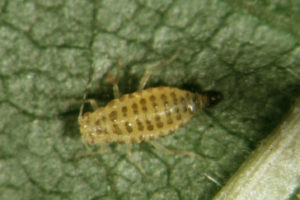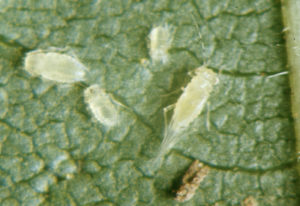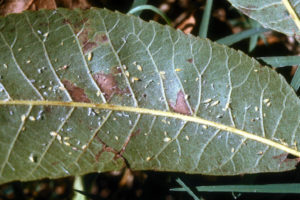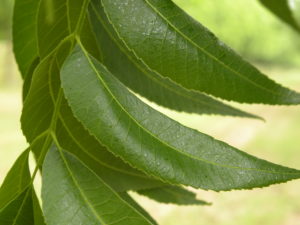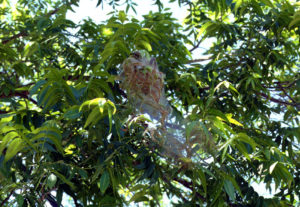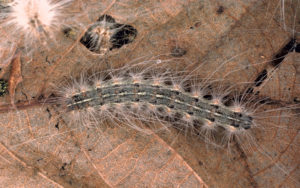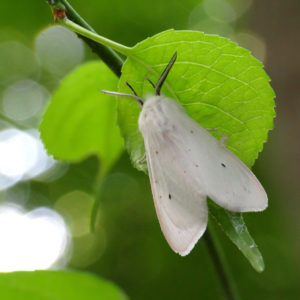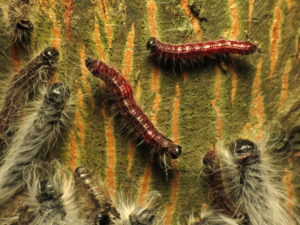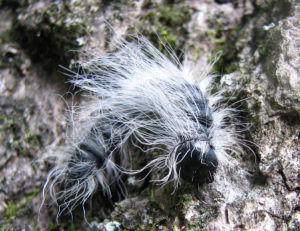Insects and mites that feed on leaves
Yellow and blackmargined aphids
Figure 12. Yellow pecan aphid life stages (top) and infestations. Yellow pecan aphid nymphs, adult laying eggs (Monelliopsis pecanis) Bissell, 1983, Louis Tedders, USDA ARS, Bugwood.org (CC BY 3.0 US); infestation (Monelliopsis pecanis) Bissell, 1983, James D. Dutcher, University of Georgia, Bugwood.org CC BY 3.0 US)
Damage: Aphids are small, soft-bodied insects that suck sap from pecan leaves. Two species of “yellow” or “honeydew” aphids that attack pecans are the blackmargined aphid and the yellow pecan aphid.
Both species have piercing/sucking mouthparts that remove water and plant nutrients from the leaf veins. As they feed, the aphids excrete large amounts of excess sugars. This sticky material, called honey- dew, collects on leaves. Honeydew is a food source for a black, sooty mold that can cover leaves when humidity is high.
Yellow pecan aphids: Compared to the blackmargined species, yellow pecan aphids usually increase later in the season. Also, they hold their wings roof-like over the body and lack the black stripe along the wing margin (Figs. 12 and 13).
Outbreaks of this species can cause late-season defoliation and reduce nut yield and quality.
Biology: The biology of both species is similar. The eggs overwinter in bark crevices on twigs and tree trunks. Immature aphids, called nymphs, hatch in spring and begin to feed on newly expanded leaves. The nymphs mature in about a week and give birth to live young. All individuals are females that reproduce without males during spring and summer. In late September and October, males and females develop, and the females deposit overwintering eggs (Fig. 12).
Control: Insecticide treatment may not be advisable for aphids because it can destroy their natural enemies, enabling the aphids to increase to even greater densities than before treat- ment. Also, yellow aphid infestations often decline rapidly (crash) because of natural enemies or rains and wind, which can dislodge the aphids from the leaves.
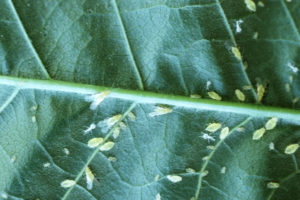
Figure 13. Blackmargined aphid infestation. Louis Tedders, USDA Agricultural Research Service, Bugwood.org (CC BY 3.0 US)
When yellow aphid control is necessary, consider products containing acetamiprid or imidacloprid and labeled for aphid control on bearing pecans (Table 1), such as:
- Bayer Advanced Fruit, Citrus and Vegetable Insect Control, which is applied to the soil
- Ortho Fruit, Flower and Vegetable Insect Killer, which is applied to the foliage
Blackmargined aphids: Winged adults have a black stripe along the outside margin of their wings, which they hold flat over the body
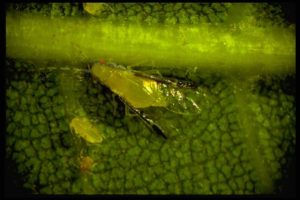
Figure 13. Blackmargined aphid winged adult. Bart Drees, Texas A&M AgriLife Extension Entomology
(Fig. 13). Blackmargined aphid infestations typically increase and may develop large populations from June to August. They often decline after about 3 weeks without causing measurable damage to foliage or yield.
Black aphids
Damage: The black pecan aphid is much more destructive than the two yellow aphid species that attack pecan trees. An infestation averaging only three black pecan aphids per com- pound leaf can cause severe leaf damage and defoliation.
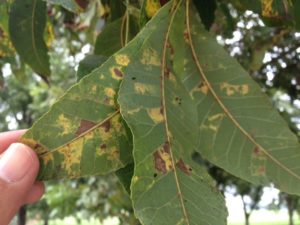
Figure 14. Black pecan aphids and damage. Photo by Bill Ree, Texas A&M AgriLife Extension Entomology
While feeding, black pecan aphids inject a toxin that turns the leaf tissue between the major veins bright yellow (Fig. 14). These damaged areas, up to ¼ inch across, turn brown. The leaves die and soon fall.
Premature defoliation often reduces nut fill and can reduce nut production the following year.
Biology: The adult is tiny and pear shaped (Fig 15). The nymphs are dark olive green, and the adults are black and may be winged.
Black pecan aphids can feed on the upper and lower leaf surfaces. Infestations often increase in August or September.
Control: Look for black pecan aphids and their characteristic leaf injury, especially in the interior of the canopy where infesta- tion often begins. If
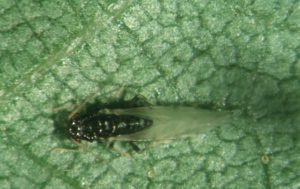
Figure 15. Black pecan aphid adult. Louis Tedders, USDA Agricultural Research Service, Bugwood.org (CC BY 3.0 US)
black pecan aphids average three or more per compound leaf, consider applying an insecticide using acetamiprid (Table 1, page 18).
Fall webworm
Damage: Fall webworm caterpillars build large, silken webs in pecan trees (Fig. 16). Each web may hold 100 or more caterpillars, which feed on pecan leaves. Large infestations may cover the tree with webs and cause extensive defoliation.
Although their webs and damage are unsightly, fall webworms do not harm established trees. However, caterpillar feed- ing can reduce nut production.
Biology: The adult is a white moth with dark spots on the wings (Fig. 17). Female moths emerge in the spring and deposit eggs in masses of several hundred. The greenish-white eggs, laid on the undersides of pecan and other tree leaves,are covered with gray hairs left by the female.
Mature larvae are about 1 inch long, pale yel- low or green, and covered with tufts of long, white hairs (Fig. 17).
There are two generations in the northern regions of Texas and four generations in South Texas. The final, or fall, generation is usually the largest and most damaging.
Control: Use a long stick to tear the webs open, which will expose the caterpillars to the birds and insects that feed on them. Sprays of spinosad or B.t. insecticide (Table 1) must penetrate the web to contact the caterpillars. Tearing open webs before spraying will improve control.
Grasshoppers
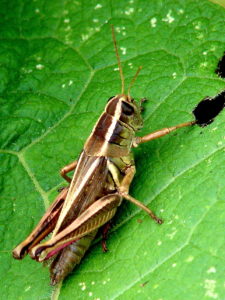
Figure 18. Grasshopper and chewing damage. Bob Travis (CC BY-NC 2.0)
Damage: Grasshoppers can move into pecan trees from nearby crops, pastures, and weedy areas (Fig. 18). They feed on pecan leaves and developing nuts.
Control: Insecticides containing bifenthrin and esfenvalerate and labeled for use on pecans will kill grasshoppers (Table 1).
However, you may have to repeat the treatment if grasshoppers continue to move into the orchard from nearby areas.
It is very difficult to control late-season grasshoppers com- pletely, and it may be impractical in years when grasshopper infestations are large and quickly reinvade treated areas.
Pecan leaf scorch mites
Damage: Pecan leaf scorch mites feed on the undersides of leaves, causing irregular brown spots. Infestations often develop first along the leaf midrib (Fig. 19). Damaged leaves appear russeted or scorched.
Large infestations can cause leaf loss, especially if the trees are under moisture stress. Premature defoliation often reduces nut fill and can reduce nut production the following year.
Biology: Scorch mites overwinter as adults in the rough bark of limbs. Adult females begin laying eggs in the spring. Mites can complete a generation in 5 to 15 days and are more numerous during hot, dry weather.
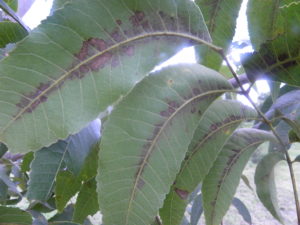
Figure 19. Damage by pecan leaf scorch mites. Photo by Bill Ree, Texas A&M AgriLife Extension Service
Control: Because scorch mites prefer the shady, interior part of the tree, they can damage it significantly before you notice the infestation. To detect infestations early, check the shady lower branches and water sprouts (shoots that arise from the trunk or branches that are several years old).
Mites may increase after some insecticides (esfenvalerate, permethrin, zeta-cypermethrin) are applied for control of other pests. Monitor the trees for mites when the weather is hot and dry and after insecticides are used.
No insecticides or miticides packaged for backyard use are effective against pecan leaf scorch mites. Insecticidal soap applied as a foliar spray may provide some benefit.
Phylloxera
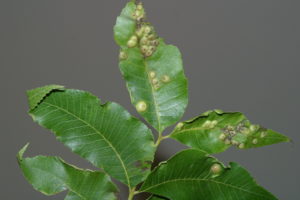
Figure 20. Galls caused by pecan leaf phylloxera. Photo by Mike Merchant, Texas A&M AgriLife Extension Service
Damage: Phylloxerae are tiny, soft-bodied insects closely related to aphids. These insects cause conspicuous swellings, called galls, to form on leaves, twigs, and nuts in the spring and early summer:
- The pecan leaf phylloxera forms galls on leaves only (Fig. 20); extensive infestations may cause some defoliation.
- Another species, the pecan phylloxera, attacks shoots and nuts and is therefore more damaging (Fig. 21). Extensive infestations of pecan phylloxera can reduce yield, impair the tree’s vitality, and curtail subsequent production.
Biology: Both species survive the winter (overwinter) as eggs in bark crevices. In the spring, tiny nymphs emerge during bud break and feed on new growth.
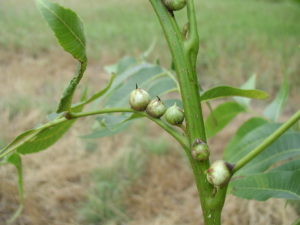
Figure 21. Galls caused by pecan phylloxera. Photo by Bill Ree, Texas A&M AgriLife Extension Service
As they feed, the nymphs secrete a substance that stimulates plant tissue to develop galls. The nymphs are soon completely enclosed in the galls, which range from 1/10 to 1 inch in diameter.
Nymphs feed and develop inside the gall. The galls then crack open and winged, adult phylloxerae emerge. Large infestations reduce leaf area and tree vigor.
Control: Apply an insecticide labeled for phylloxerae (Table 1). Use it in the spring to kill immature phylloxerae after they hatch from overwintering eggs but before they cause the galls to appear. Apply it after bud break when the leaves have grown 1 to 2 inches long.
Only infested trees need treatment because phylloxerae cannot fly far, and infestations move slowly from tree to tree.
Walnut Caterpillar
Figure 22. Walnut caterpillar young (left) and full-grown larvae (middle and right)
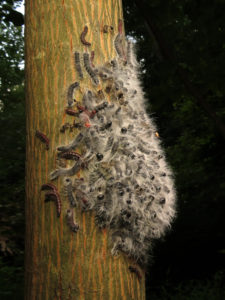
Figure 23. Walnut caterpillars congregating to shed their skins. Katja Schulz (CC BY 2.0)
Damage: Walnut caterpillars feed in large numbers on pecan leaves but do not build silken webs as do fall webworms. The larvae eat the leaves, leaving only the midribs and leaf stems.
Premature defoliation can reduce nut fill and nut production the following year.
Biology: Walnut caterpillar moths deposit masses of 500 or more eggs on the undersides of leaves. The masses are round, hairless, free of scales, and about the size of a half dollar. The eggs hatch in about 10 days.
The larvae feed for about 25 days. Young larvae are reddish brown with yellow lines running the length of the body. Full- grown larvae are about 2 inches long, black with grayish lines, and covered with long, soft, gray hairs (Fig. 22).
The larvae congregate in large masses on the trunk (Fig.23) and scaffold branches to shed their skins before crawling back to finish feeding on leaves. These final-stage larvae consume most of the leaves and can defoliate a tree very quickly. Mature larvae crawl to the soil to pupate.
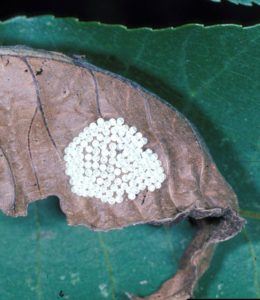
Figure 24. Walnut caterpillar egg mass. 24. Walnut caterpillar (Datana integerrima) Grote & Robinson, Lacy L. Hyche, Auburn University, Bugwood. org (CC BY 3.0 US)
Control: Because walnut caterpillars do not build tents or webs, infestations often go unnoticed until leaf damage becomes obvious.
To find the egg masses (Fig. 24), shine a flashlight on the undersides of the leaves at night. Look for white spots about 1 inch in diameter.
Caterpillars cause 80 percent of their damage during the last 3 to 4 days of feeding. Smaller larvae are easier than larger larvae to kill with insecticides; controlling the younger ones prevents serious damage.
If large infestations threaten to defoliate the trees, consider applying an insecticide containing esfenvalerate or spinosad (Table 1).
Table 1. Some insecticides labeled for control of insect pests in pecans and available in small quantities for use by backyard growers
| Active ingredient | Brand name(1) | Targeted pest | Notes |
|---|---|---|---|
| acetamiprid 0.5% | Ortho Flower, Fruit and Vegetable Spray | Aphids, phylloxera, scale, and others | Wait 14 days after application before harvest. |
| Bacillus thuringiensis, B.t. | Bonide Thuricide B.t. | Fall webworms, other leaf- feeding caterpillars | — |
| bifenthrin | Fertilome Broad Spectrum Insecticide, 0.3% | Aphids, fall webworm | Wait 21 days after application before harvest. |
| bifenthrin and zeta- cypermethrin | Ortho Bug B Gone Insect Killer for Lawns and Gardens | Grasshoppers, pecan nut casebearer, pecan phylloxera, pecan weevil, stinkbugs |
Wait 21 days after application before harvest. |
| dormant oils | Hi-Yield Dormant Spray- 98.8% mineral oil | Phylloxera, scale | Read the product label for guidelines on plant sensitivity and temperature restriction before using these products. |
| esfenvalerate | Monterey Bug Buster II, 0.425% | Grasshoppers, hickory shuckworm, pecan nut casebearer, pecan weevil, phylloxera, scale crawlers | — |
| horticultural oil | Bonnide All Seasons Horticultural and Dormant Spray Oil | Scale | Read the product label for guidelines on plant sensitivity and temperature restriction before using these products. |
| Fertilome Horticultural Oil Spray | — | ||
| Monterey Horticultural Oil | |||
| imidacloprid | Bayer Advanced Fruit, Citrus and Vegetable Insect Control 0.235% | Aphids | Apply as a drench to the soil around the dripline of the tree. Wait 7 days after application before harvesting nuts from treated trees. Only 1 application per year |
| Hi-Yield Systemic Insect Spray 1.47% | Aphids, phylloxera | Apply as a foliar spray. Wait 7 days after application before harvest. | |
| malathion | Martins Malathion 57% | Pecan nut casebearer, phylloxera | Wait 7 days after application before harvest. Do not enter treated area for 24 hours. |
| permethrin | Bonide Eight Vegetable, Fruit and Flower Concentrate, 2.5% | Caterpillar pests, grasshoppers | — |
| Martin’s Vegetable Plus, 10.0% permethrin | Wait 7 days after application before harvest. | ||
| potassium salts | Fertilome Insecticidal Soap | Aphids, scale crawlers | — |
| Safer Insect Killing Soap | |||
| spinosad | Bonide Captain Jacks Dead Bug Concentrate, 0.5% | Hickory shuckworm, pecan nut casebearer, webworm | Wait 1 day after application before harvest. |
| Ferti-Lome Natural Guard, 0.5% | Wait 1 day after application before harvest. Approved by OMRI2 for organic production | ||
| Green Light Lawn and Garden Spray, 0.5% | Approved by OMRI2 for organic production; see label for pre-harvest interval | ||
| Monterey Garden Insect Spray, 0.5% | Wait 1 day after application before harvest. Approved by OMRI2 for organic production |
1: The effectiveness of many of these products has not been fully evaluated in university trials. This information is provided for educational purposes. Read and follow the product label directions.
2: Organic Materials Review Institute

